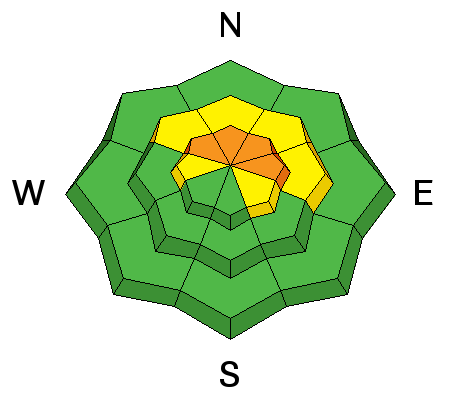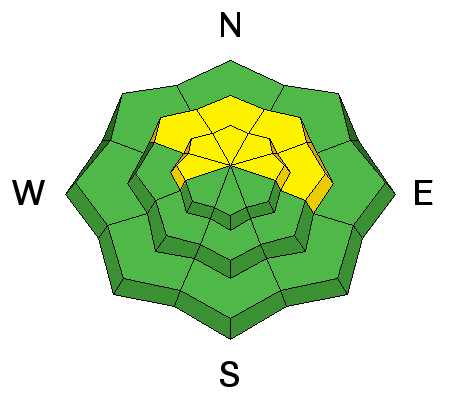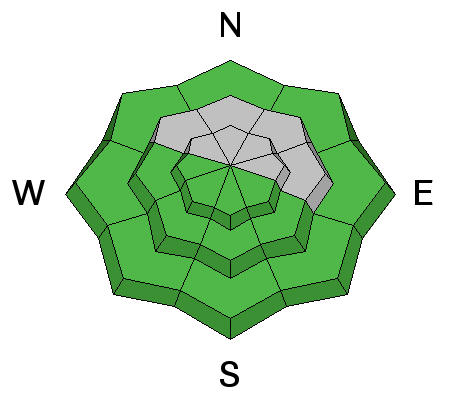25th Annual Black Diamond Fall Fundraising Party
Thursday, September 13; 6:00-10:00 PM; Black Diamond Parking Lot

25th Annual Black Diamond Fall Fundraising Party
Thursday, September 13; 6:00-10:00 PM; Black Diamond Parking Lot
| Advisory: Moab Area Mountains | Issued by Eric Trenbeath for Saturday - March 24, 2018 - 6:52am |
|---|
 |
special announcement Episode 7 of the UAC Podcast "Mastery and False Mastery - An Interview with 'Big' Don Sharaf" is live. With a snow career spanning over 30 years, Don has enough mileage in the mountains to have learned a thing or two, including the profound value of humility when staring into the face of the dragon. Listen in on our conversation about the idea of mastery and if such a thing can exist in the avalanche world. Check it out on the UAC blog, ITunes, Stitcher, or wherever you get your podcasts. The UAC Marketplace is still open. Our online marketplace still has deals on skis, packs, airbag packs, beacons, snowshoes, soft goods and much more. INSTAGRAM! We now have a UAC-Moab Instagram page. You can find it here....but better yet follow us on your smartphone. Confused? Ask a teenager. |
 |
current conditions A few high clouds are streaming over the area, 10,000' temps are in the low 20's, and southerly winds are averarging 20-25 mph with gusts to 40 along ridgetops. Yesterday's storm delivered 4"-6" of heavy, dense snow with just overn an inch of water. I've never skied or ridden in the Pacific Northwest, but if not for the glimpses of red rock desert beneath the cloud ceiling yesterday, that's where I easily could have been. The snow surface is creamy, but also punchy and upside down feeling. Base depth in Gold Basin: 49" Base depth at Geyser Pass Trailhead: 30" New snow totals in Gold Basin. Snow totals at the Geyser Pass Trailhead, (9600') Wind, temperature, and humidity on Pre Laurel Peak (11,700') Road conditions to Geyser Pass Trailhead: The road is sloppy with mud at the bottom and 5" of wet snow at the parking lot. Several vehicles were up yesterday and ruts in the snow are up to 8" deep in drifted areas. Grooming conditions: Trails were packed out into Gold Basin yesterday. |
 |
recent activity |
| type | aspect/elevation | characteristics |
|---|


|


|

LIKELIHOOD
 LIKELY
UNLIKELY
SIZE
 LARGE
SMALL
TREND
 INCREASING DANGER
SAME
DECREASING DANGER
|
|
description
Strong southerly winds and heavy dense snow have formed stiff wind slabs in exposed terrain right around treeline and above. In many areas these new slabs are overlying lower density snow giving them a hollow base. Avoid slopes that have a smooth, rounded, fat appearance, or that feel hollow under foot.. A triggered wind slab also has the potential to step down into a buried weak layer causing a deeper and more dangerous persistent slab avalanche. Choose slopes wisely and avoid steep convexiiteis and blind break overs. A few of the ridges are starting to develop large cornices. Give cornices a wide berth when you are traveling on ridge crests where they are present and be aware of what's above you. |
| type | aspect/elevation | characteristics |
|---|


|


|

LIKELIHOOD
 LIKELY
UNLIKELY
SIZE
 LARGE
SMALL
TREND
 INCREASING DANGER
SAME
DECREASING DANGER
|
|
description
The persistent slab problem is tricky and variable - some areas have relatively strong snow and other areas still have very weak, sugary, faceted snow at the base. The weakest areas are in steep, rocky, and wooded terrain right around tree line and above. Slopes with an easterly component are the most suspect. The snowpack may be stronger on more open slopes and bowls. The only way to know for sure is to dig down and perform a stability test. Also keep in mind that thinner areas along slope margins and near rock outcroppings can provide trigger points and avalanches up to 4' deep remain possible. |
| type | aspect/elevation | characteristics |
|---|


|


|

LIKELIHOOD
 LIKELY
UNLIKELY
SIZE
 LARGE
SMALL
TREND
 INCREASING DANGER
SAME
DECREASING DANGER
|
|
description
With temperatures rising into the high 30's or even low 40's there is also the danger for loose wet avalanches on sun exposed slopes. These should be mostly small but could prove dangerous on the wrong slope. Signs of instability include roller balls, pinwheels, and punchy or sloppy wet snow. Get off of, and stay out from under steep slopes when these signs are present.
Even small slides such as this are an indicator of wet snow instability. (Tim Mathews photo) |
 |
weather Today look for mostly sunny skies and breezy conditions. Southwest winds will blow in the 20 mph range along ridge tops and high temperatures at 10,000' will be in the upper 30's.
|
| general announcements The UAC has new support programs with Outdoor Research and Darn Tough. Support the UAC through your daily shopping. When you shop at Smith's, or online at Outdoor Research, REI, Backcountry.com, Darn Tough, Patagonia, NRS, Stio, Amazon, and eBay a portion of your purchase will be donated to the FUAC. See our Donate Page for more details on how you can support the UAC when you shop. Benefit the Utah Avalanche Center when you buy or sell on eBay - set the Utah Avalanche Center as a favorite non-profit in your eBay account here and click on eBay gives when you buy or sell. You can choose to have your seller fees donated to the UAC, which doesn't cost you a penny. This information does not apply to developed ski areas or highways where avalanche control is normally done. This advisory is from the U.S.D.A. Forest Service, which is solely responsible for its content. This advisory describes general avalanche conditions and local variations always occur. |